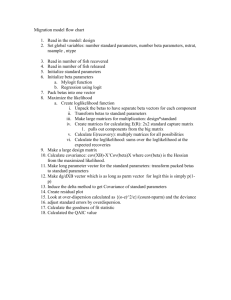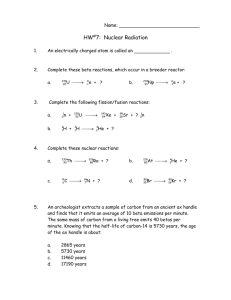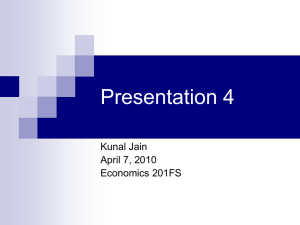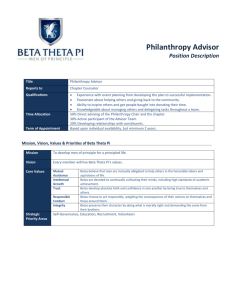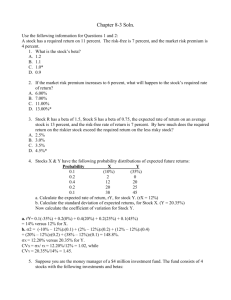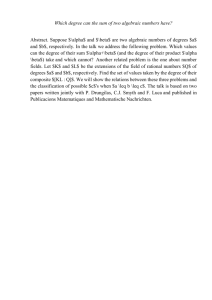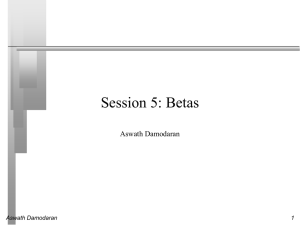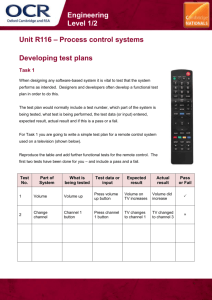Growth Options, Beta, and the Cost of Capital
advertisement
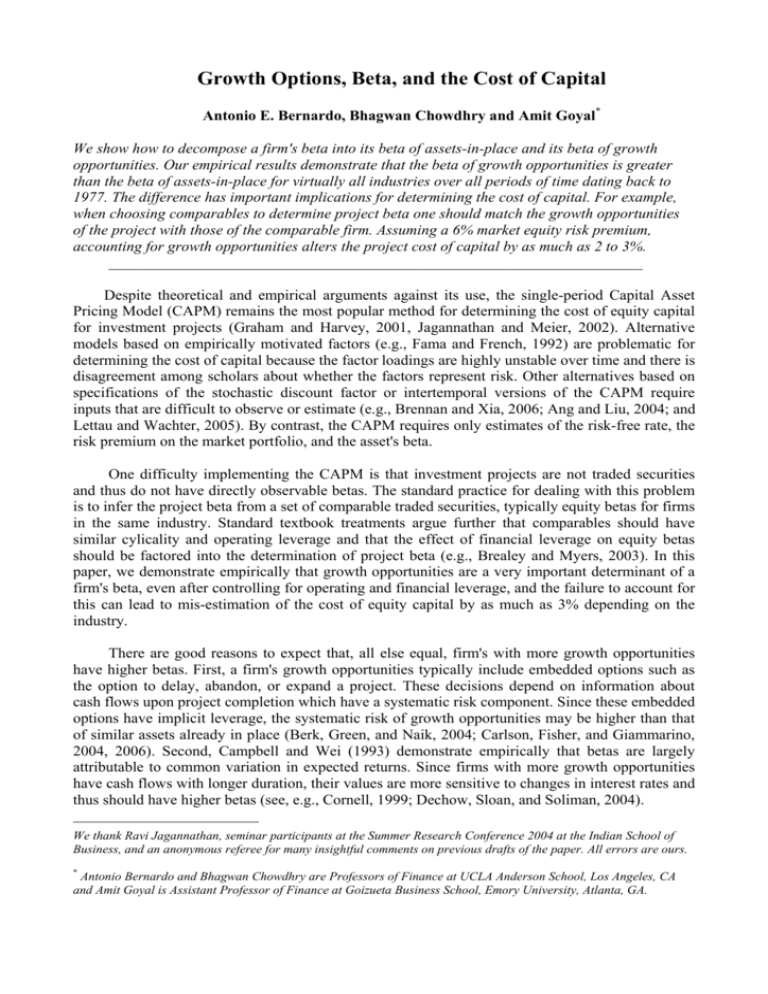
Growth Options, Beta, and the Cost of Capital Antonio E. Bernardo, Bhagwan Chowdhry and Amit Goyal* We show how to decompose a firm's beta into its beta of assets-in-place and its beta of growth opportunities. Our empirical results demonstrate that the beta of growth opportunities is greater than the beta of assets-in-place for virtually all industries over all periods of time dating back to 1977. The difference has important implications for determining the cost of capital. For example, when choosing comparables to determine project beta one should match the growth opportunities of the project with those of the comparable firm. Assuming a 6% market equity risk premium, accounting for growth opportunities alters the project cost of capital by as much as 2 to 3%. _____________________________________________________________________ Despite theoretical and empirical arguments against its use, the single-period Capital Asset Pricing Model (CAPM) remains the most popular method for determining the cost of equity capital for investment projects (Graham and Harvey, 2001, Jagannathan and Meier, 2002). Alternative models based on empirically motivated factors (e.g., Fama and French, 1992) are problematic for determining the cost of capital because the factor loadings are highly unstable over time and there is disagreement among scholars about whether the factors represent risk. Other alternatives based on specifications of the stochastic discount factor or intertemporal versions of the CAPM require inputs that are difficult to observe or estimate (e.g., Brennan and Xia, 2006; Ang and Liu, 2004; and Lettau and Wachter, 2005). By contrast, the CAPM requires only estimates of the risk-free rate, the risk premium on the market portfolio, and the asset's beta. One difficulty implementing the CAPM is that investment projects are not traded securities and thus do not have directly observable betas. The standard practice for dealing with this problem is to infer the project beta from a set of comparable traded securities, typically equity betas for firms in the same industry. Standard textbook treatments argue further that comparables should have similar cylicality and operating leverage and that the effect of financial leverage on equity betas should be factored into the determination of project beta (e.g., Brealey and Myers, 2003). In this paper, we demonstrate empirically that growth opportunities are a very important determinant of a firm's beta, even after controlling for operating and financial leverage, and the failure to account for this can lead to mis-estimation of the cost of equity capital by as much as 3% depending on the industry. There are good reasons to expect that, all else equal, firm's with more growth opportunities have higher betas. First, a firm's growth opportunities typically include embedded options such as the option to delay, abandon, or expand a project. These decisions depend on information about cash flows upon project completion which have a systematic risk component. Since these embedded options have implicit leverage, the systematic risk of growth opportunities may be higher than that of similar assets already in place (Berk, Green, and Naik, 2004; Carlson, Fisher, and Giammarino, 2004, 2006). Second, Campbell and Wei (1993) demonstrate empirically that betas are largely attributable to common variation in expected returns. Since firms with more growth opportunities have cash flows with longer duration, their values are more sensitive to changes in interest rates and thus should have higher betas (see, e.g., Cornell, 1999; Dechow, Sloan, and Soliman, 2004). We thank Ravi Jagannathan, seminar participants at the Summer Research Conference 2004 at the Indian School of Business, and an anonymous referee for many insightful comments on previous drafts of the paper. All errors are ours. * Antonio Bernardo and Bhagwan Chowdhry are Professors of Finance at UCLA Anderson School, Los Angeles, CA and Amit Goyal is Assistant Professor of Finance at Goizueta Business School, Emory University, Atlanta, GA. Our goal in this paper is to demonstrate empirically the link between a firm's growth opportunities and its asset beta and to provide simple rules for choosing the project beta based on our results. Our empirical framework is very simple. The value of a firm can be separated into the value of assets-in-place and growth opportunities, thus a firm's asset beta is simply a valueweighted average of the betas of each. We make two assumptions to disentangle the betas of assetsin-place and of growth opportunities from the data. First, we assume that a firm's book-to-market ratio is a good proxy for the ratio of the value of assets-in-place to the total value of the firm. Second, we assume that the beta of assets-in-place and the beta of growth opportunities are constant for all firms within an industry at a given time. Thus, we assume that the variation in firm betas within an industry at a moment in time is explained completely by the relative proportion of the value of assets-in-place to growth opportunities. Our empirical results are striking. For our full sample period of 1977-2004, the difference between the beta of growth opportunities and the beta of assets-in-place is positive and statistically significant, at the 95% level, in 34 of 37 industry classifications (excluding financials, miscellaneous, etc. from the Fama-French 48-industry classification). The difference in betas can be substantial. For example, in fast-growing industries such as Computers, Medical Equipment, and Pharmaceutical Products the difference is 0.588 , 0.714 , and 0.792 , respectively. To translate these differences into betas for projects with below, typical, or above-average growth opportunities we measure unlevered firm betas at the 25th, 50th, and 75th percentile book-to-market ratios for the industry. We summarize our findings by constructing a table of unlevered betas for each industry depending on whether the firm's market-to-book ratio is typical, above, or below the industry average. For example, in the period 2000-2004, the unlevered beta estimate for a project with above (below) average growth opportunities in the Computer industry is 1.785 ( 1.43 ) which suggests that a 100% equity financed project with above-average growth opportunities in the Computer industry should have a cost of equity capital roughly 2% per year higher than a project with below-average growth opportunities (assuming a 6% market risk premium). Given our results, the relative proportion of growth opportunities and assets-in-place is an important determinant of an investment's beta. Consequently, the beta of assets-in-place is an appropriate measure of risk for mature firms with few growth opportunities whereas the beta of growth opportunities is an appropriate measure of risk for young startup firms.1 In general, when choosing comparable firms to infer an investment's beta, one must choose firms based on proxies for their growth opportunities, e.g., market-to-book ratios. I. Theoretical Relation Between Growth Options and Beta The link between a firm's beta and its growth opportunities has been discussed in the literature. Carlson, Fisher, and Giammarino (henceforth CFG; 2004, 2006) demonstrated that growth opportunities have implicit leverage and therefore the beta of growth opportunities exceeds the beta of assets-in-place. In this section, we present a simplified and slightly modified version of the results proved in CFG. Consider a firm with assets-in-place with market value at time t , denoted At , which follows the diffusion process dAt /At = µdt + σdzt , (1) where µ is the expected growth rate of the return on assets-in-place, σ is the return volatility, and zt is a standard Wiener process. The firm also has a growth opportunity which allows it to 1 Indeed, Kaplan and Peterson (1998) document that the betas of large-market-capitalization firms tend to be lower than the betas of small-capitalization firms. 2 duplicate the cash flows of the assets-in-place for an investment of I . In other words, the firm has an option on its assets-in-place. Let Gt denote the value of the firm's growth opportunity at date t . Assuming that this investment opportunity may be undertaken at some future date t + T and that the risk of the firm's assets-in-place is spanned by the returns on a tradeable asset, the value of the growth opportunity in a frictionless market is given by the Black-Scholes formula Gt = N (d1 ) At − N (d 2 ) Ie − rT , (2) where ln ( At /Ie − rT ) + 0.5(σ T ) 2 d1 = , (3) σ T and d 2 = d1 − σ T , (4) 2 and N (⋅) is the cumulative distribution function for the standard normal distribution. Let β tA denote the beta of the firm's assets-in-place at date t and similarly let β tG denote the beta of the firm's growth opportunity at date t . It is straightforward to show that dG /dA β tG = t t β tA , (5) Gt /At and it is also well-known that dGt /dAt = N (d1 ) thus it follows that β tG > β tA . The intuition is simple: the firm's growth opportunity is an option on its assets-in-place and since this option has implicit leverage the beta of its growth opportunity is greater than the beta of its assets-in-place. Other theories linking firm betas to its growth opportunities can be found in the literature. Berk, Green, and Naik (2004) demonstrate, in the context of the valuation of new ventures, that the decision to continue with a project often depends on the outcome of systematic uncertainty. This compound option on systematic uncertainty imparts implicit leverage on the growth opportunity which gives it higher systematic risk than the underlying assets-in-place. A distinct theoretical mechanism is posited in Berk, Green, and Naik (1999). They argue that, holding expected cash flows constant, firms will tend to accept projects with low risk and reject projects with high risk; consequently, assets-in-place tend to be less risky than the firm's growth opportunities. An alternative reason for differences in the beta of growth opportunities and the beta of assetsin-place is discussed in Campbell and Mei (1993), Cornell (1999), and Dechow, Sloan, and Soliman (2004). Campbell and Mei (1999) demonstrate empirically that betas are largely attributable to common variation in expected returns. Since the cash flows from growth opportunities tend to come further in the future than the cash flows from assets in place, Dechow, Sloan, and Soliman (2004) argue that the impact of common variation in expected returns is greater for firms with more growth opportunities. Thus an increase in the interest rate, for example, may not only cause a drop in the value of the market portfolio but may also cause the value of growth opportunities to drop more than the value of assets in place, implying a higher covariation between market returns and longerduration assets (i.e., a higher beta). Using similar reasoning, Cornell (1999) argues that the beta of pharmaceutical companies such as Amgen are too large to be explained by the systematic risk of their cash flows. In the empirical framework described below, we are agnostic about the source of the difference between the beta of growth opportunities and the beta of assets-in-place. The 2 The Black-Scholes model applies to European options but firms can also choose when to undertake a project. These timing options are an important part of real options; however, the theoretical analysis in CFG shows that the relation between growth options and risk is robust to endogenizing the timing decision. 3 implications of the knowledge that β G > β A for capital budgeting at a company such as Amgen is that the systematic risk of an R&D project is greater when it is earlier in its life cycle. Our goal is to provide quantitative support for this hypothesis and practical guidance for the choice of discount rate. II. Estimating the Impact of Growth Options on Beta To quantify the impact of the firm's growth opportunities on the firm's asset beta we begin by decomposing the value of firm i at time t into two components: the value of assets-in-place, Ai ,t , and the present value of growth opportunities, Gi ,t : Vi ,t = Ai ,t + Gi ,t . (6) The firm's asset beta is then simply a weighted average of the beta of assets-in-place and the beta of growth opportunities: A A (7) β i ,t = i ,t β iA,t + 1 − i ,t β iG,t . Vi ,t Vi ,t To operationalize this decomposition, we make two important assumptions. First, we assume A that the ratio of the value of assets-in-place to the total value of the firm, i ,t , is proxied by the Vi ,t ratio of the book value of long-term outstanding debt plus book value of common equity to the book value of debt plus the market value of equity of firm i at time t . The book value of long-term outstanding debt is given in item 9 of the Compustat data. The book value of common equity is determined using the method in Fama and French (1992). Second, to disentangle the beta of assets-in-place and the beta of growth opportunities, we assume that these betas are the same for all firms in the same industry at any date. This implies that the variation in firm betas within an industry at any date is determined by the variation in the proportion of the value of assets-in-place to the total value of the firm. Thus, we allow the betas of assets-in-place and growth opportunities within an industry to vary over time but we assume these betas do not vary across firms within an industry at any point in time. Although there are good reasons to believe that there is within-industry variation in the betas of assets-in-place and growth opportunities (e.g., firms within an industry may be at a different point in their life-cycle), we suspect this variation is relatively small thus the cost of making this assumption is small compared to the benefits from reducing estimation error via aggregation. Firms are assigned to industries by taking their primary 4-digit SIC code and sorting according to the Fama and French (1997) 48industry classification. With these assumptions we have the following relation: A β i ,t = β tG − ( β tG − β tA ) i ,t , Vi ,t (8) for all firms i in a given industry at time t . The β i,t is the firm's unlevered beta which is obtained by (i) computing the firm's equity beta based on a one-factor market model using a five-year rolling window (three-year minimum) and updated annually, and (ii) unlevering the equity beta using the formula: 4 β i ,t = β iE,t , 1 + (1 − τ ) Di ,t /Ei ,t (9) where β i,Et is the equity beta of firm i at time t , τ is the tax rate (assumed to be 33 percent for the entire sample period), and Di ,t /Ei ,t is the ratio of long-term debt to market value of equity for firm i at time t . We also winsorize the debt-to-equity ratio data by setting the smallest and largest 0.5% of observations to the next largest or smallest value of these ratios. The choice of 0.5% is not critical: our results carry through both without winsorizing and when the data is winsorized at different levels up to 5%. One way to estimate β tG and β tA would be to estimate the intercept and the slope using the following cross-sectional regression: A βˆi ,t = β tG − ( β tG − β tA ) i ,t + ε i ,t , (10) Vi ,t where ε i,t represents the measurement error in the estimate of β i,t . However, we do not run regression ((10)). This is because our regressor Ai ,t is proxied by the book-to-market ratio which is Vi ,t a noisy measure of the ratio of the value of assets-in-place to the total value of the firm. We construct two portfolios of firms based on their market-to-book values and then compute (equalweighted) means of the market-to-book and unlevered beta for these two portfolios. The `regression' line is then just a straight line that connects these two points and gives us the intercept and slope coefficients. In Section IV we perform a number of robustness checks to address the errors-in-variables problem. III. Empirical Results Our empirical analysis covers the period 1977 to 2004. The reason for this is that the NASDAQ stocks are included in CRSP beginning in 1973 and we need five years of data to estimate equity betas. Table I provides estimates of industry (asset) betas over the periods 20002004, 1995-2004, and 1977-2004, for 37 of the Fama-French 48-industry classifications (excluding financials, miscellaneous, etc.).3 We report the mean unlevered beta as well as the unlevered beta for firms with 25th percentile market-to-book (Q1) and 75th percentile market-to-book (Q3) for that industry. In all periods and all industries, firms with above-average growth opportunities (high market-to-book ratios) have higher unlevered betas than firms with below-average growth opportunities (low market-to-book ratios). The data strongly support our hypothesis that the beta of growth opportunities exceeds the beta of assets-in-place. To get a sense of the importance for practical capital budgeting problems, consider the Computer industry. For the period 2000-2004, the mean unlevered firm beta in this industry is 1.608; however, a firm at the 25th percentile in market-to-book has an unlevered beta of 1.430 while a firm at the 75th percentile in market-to-book has an unlevered beta of 1.785. This difference in beta of 0.355 represents a roughly 2% higher cost of capital for a project with relatively high growth opportunities relative to a project with relatively low growth opportunities (when using a 6% market equity risk premium). Our results are consistent with the empirical results in Carlson, Fisher, and Giammarino (2004) but seemingly at odds with Fama and French (1992) who find only a weak cross-sectional correlation between equity betas and equity book-to-market ratios. There are two reasons for this. First, Fama and French examine the relation between equity betas and equity book-to-market ratios 3 The results for other 5 and 10 year sample periods are similar but not reported for brevity. 5 whereas we examine the relation between unlevered betas and firm book-to-market ratios. Unlevering might produce a stronger negative relation between unlevered betas and firm book-tomarket ratios because market leverage and book-to-market are negatively correlated. To check this we compare the cross-sectional correlation between (i) firm equity betas and equity book-to-market ratios and (ii) firm asset betas and firm book-to-market ratios using annual data from 1977-2004. We find a correlation of − 0.058 between equity betas and equity book-to-market ratios (consistent with the low correlation in Fama and French) but find a stronger negative correlation of − 0.124 between asset betas and firm book-to-market ratios. Second, Fama and French examine the correlation between equity betas and equity book-to-market ratios without controlling for industry whereas we sort by industry. We compute the cross-sectional correlation between firm asset betas and firm book-to-market ratios sorted by industry every year. We then average the correlations across industries to get a single correlation in each year and then average these annual correlations over the entire sample data period 1977-2004. The average annual correlation between asset betas and firm book-to-market ratios, when sorted by industry, increases to − 0.225 . Taken together, these two effects reconcile our results with Fama and French (1992). Table II provides estimates of asset betas, growth betas, and the difference between the growth and asset betas for all industries averaged over the same sample periods as those in Table I. These estimates are calculated using Equation (2). Over the whole sample period of 1977-2004, we find that in all but one industry, Precious Metals, the beta of growth opportunities is greater than the beta of assets-in-place, β G > β A . The differences in the average betas of growth opportunities and the average betas of assets-in-place over the whole sample period are statistically significant for 34 of the 37 industries at the 95% level. The difference is as high as 1.095 for the Healthcare industry which implies that the cost of capital difference between a startup in that industry and a mature firm with no growth options could be as high as 6.6% assuming a 6% market risk premium. IV. Robustness Checks As we mentioned earlier, we use the book-to-market ratio as a proxy for the ratio of the value A of assets-in-place to the total value of the firm, i ,t . We also used other proxies for the value of Vi ,t assets-in-place. For example, we assumed that the assets-in-place generate a level perpetuity of cash C flows so that the value of assets-in-place is given by Ai ,t = i ,t where Ci ,t is the cash flows of firm ri i at date t and ri is the firm's discount rate. Instead of cash flows, we also used earnings in the numerator. We also considered the possibility that the value of assets-in-place may exceed the total value of the firm so that the value of growth opportunities is negative. This possibility is reasonable if, for example, the firm's cash flows are expected to decline over time (e.g., tobacco industry); however, this possibility is unreasonable if growth opportunities reflect the option to expand in which case the value of growth opportunities is bounded below by zero. We conducted the analysis with and without censoring the value of growth opportunities. The results of these robustness checks are similar to those in the paper and are not reported for brevity. A Since the book-to-market ratio, and other proxies we considered, are noisy measures of i ,t , Vi ,t the errors-in-variables problem may bias downward the slope coefficients in our regression. To see if this indeed the case, we performed two robustness checks. First, we repeat our exercise with finer levels of aggregation by constructing four and eight portfolios as well as using all individual firms in each industry. We run the same regression in equation (2) for these exercises and calculate the slope coefficient (the difference between asset and 6 growth betas).4 Not surprisingly, our slope coefficients are on average smaller when the regressor is more disaggregated. For instance, the average slope coefficient (across all industries and all years in the sample period) is 0.579 with two portfolios, 0.479 with four portfolios, 0.431 with eight portfolios, and 0.331 with all individual firms. Unreported results for individual years and industries show that our main empirical results hold up extremely well even when we run our regressions with individual stocks. Second, we use instrumental variables (IV) regression. A standard approach to deal with our measurement error is to look for instrumental variables whose measurement error is uncorrelated with the measurement error in our proxy (book-to-market). The slope coefficient from the IV regression is a consistent estimator of the true slope and helps in eliminating the attenuation bias. The difficulty, of course, is in choosing the appropriate instruments. We experiment with three different instruments: the earnings-to-price ratio (E/P), the cash flow-to-price ratio (CF/P), and the dividend yield (D/P). For each of these instruments, we run the standard OLS regression and the IV regression for each year and each industry (using all firms in each industry). We perform the Hausman specification test for each of these regressions to test for the null that the regression error is uncorrelated with the regressor. The Hausman test rejects the null (at 95% significance level using a critical value of χ12 = 3.84 ) in approximately 10% of the cases (9.9% for E/P, 13.9% for CF/P, and 11.1% for D/P). In these cases, we use the IV estimate but in the rest of the cases, we use the OLS estimate for the slope coefficient. The results of these exercises are mostly encouraging. The slope estimate thus constructed is typically larger than the standard OLS estimate. With CF/P as the instrument, the average difference between asset and growth betas (across all years and all industries) is 0.550 which is very close to the estimate of 0.579 that we obtain with aggregation to two portfolios.5 Finally, standard textbook treatments suggest that when choosing comparable firms to infer project betas one should use firms with similar operating leverage (e.g., Brealey and Myers, 2003). Since operating leverage and market-to-book ratios are correlated, one might suspect that our distinction between high growth and low growth firms is a manifestation of differences in operating leverage. To check this, we do an independent, double sort of firms within an industry into high and low market-to-book and high and low operating leverage. Operating leverage is not directly measurable, but is reasonably proxied by net margins calculated as the ratio of EBITDA to Net Sales. We calculate the betas of assets-in-place and growth opportunities using Equation (2) separately for low and high operating leverage firms. The difference between the betas of assets-inplace and growth opportunities are presented in Table III. We find that for both groups of firms, the beta of growth opportunities is greater than the betas of assets-in-place in virtually all industries (with the exception of Precious Metals). The differences are also statistically significantly for most of the 37 industries. We conclude that our results are not driven by differences in operating leverage across firms. V. Implications for Capital Budgeting Our analysis suggests some important rules of thumb when applying the CAPM to investment projects. For example, rolling out a retail outlet in a new market with numerous options to expand should have a higher cost of capital than opening a new outlet in a mature, highly competitive market. When choosing comparables to estimate project beta, a high-growth retailer is a better 4 Regression in these exercises is a true regression. In other words, we find the best possible fit of the line (instead of having one straight line connecting two points as is the case with two portfolios). 5 The same exercise using E/P as an instrument yields an average difference between the asset and growth betas of 0.283 and using D/P as an instrument yields an average difference of 1.193 . 7 choice in the former case whereas a low-growth retailer is a better choice in the latter case. The following example from the Computers industry illustrates this idea. Consider two firms: Cognex Corp. (ticker CGNX) and Intergraph Corp. (ticker INGR). Both firms are similar in size (market capitalization of $785.6 and $819.8 million, respectively) and both firms have no leverage. The standard textbook prescription of finding comparable companies in the same industry and with the same size and financial structure applies here yet the betas are very different: Cognex's beta is 2.00 while Intergraph's beta is 0.80 (all numbers are for 2002). Which firm makes a better comparable for evaluating the risk of an investment in the Computers industry? We suggest that one also look at the growth options embedded in each firm (proxied by the market-to-book ratio). Cognex's market-to-book ratio is 2.22 while Intergraph's market-to-book ratio is 1.32 which suggests that Cognex has more growth options/opportunities than Intergraph. Thus, we believe Cognex is a better comparable for evaluating the risk of an investment project with many growth options while Intergraph is a better comparable for evaluating the risk of an investment project with few growth options. Since there is a lot of noise in estimated betas for individual firms, many scholars have suggested using industry betas for all firms in the industry (Fama and French, 1997). We refine this suggestion by computing three betas for each industry: the mean unlevered beta of all firms with low market-to-book ratios, the mean unlevered beta of all firms in the industry (the industry cost of capital), and the mean unlevered beta of firms with high market-to-book ratios. Projects with low, medium, and high growth opportunities can be assigned these three betas, respectively. Another implication of our analysis is that the firm's own beta may not always be a good measure of the systematic risk of one of its investment projects, even if it is in the same line of business. Our analysis suggests that one must consider whether the firm has relatively more or less growth opportunities than the project. For example, consider Amgen which has both established drugs, such as Epogen and Neupogen, and numerous R&D projects in the pipeline. Amgen's beta may not be a good estimate of the beta of one of its R&D projects. At the same time, it may not be a good estimate of the beta of one of its divisions which has a proven drug that is already generating significant cash flows. The beta of this division should be smaller and if the firm beta is used to discount its cash flows it is likely to underestimate the value of the division. This can be important if, for example, the firm is trying to divest the division with significant cash flows. We can also use our method to determine the discount rate for startup firms. This is a particularly vexing problem in valuation because the usual difficulty in finding comparables is exacerbated for startups. Ignoring the issue of startups being fundamentally different from public firms, we can consider a startup as a firm with no assets-in-place but only growth options. Our method estimates the beta of growth options for the industry and this can be used to discount projected cash flows for a startup in the industry. 8 References Ang, A. and J. Liu, 2004, “How to Discount Cashflows with Time-Varying Expected Returns,” Journal of Finance 59, 2745-2783. Berk, J., R. Green, and V. Naik, 1999, “Optimal Investment, Growth Options and Security Returns,” Journal of Finance 54 , 1553-1608. Berk, J., R. Green, and V. Naik, 2004, “Valuation and Return Dynamics of New Ventures,” Review of Financial Studies 17, 1-35. Brealey, R.A. and S.C. Myers, 2003, Principles of Corporate Finance, New York, NY, McGrawHill Irwin. Brennan, M.J. and Y. Xia, 2006, “Risk and Valuation under an Intertemporal Capital Asset Pricing Model,” Journal of Business 79, 1-35. Campbell, J.Y. and J. Mei, 1993, “Where do Betas Come From? Asset Price Dynamics and the Sources of Systematic Risk,” Review of Financial Studies 6, 567-592. Carlson, M., A. Fisher, and R. Giammarino, 2004, “Corporate Investment and Asset Price Dynamics: Implications for the Cross-section of Returns,” Journal of Finance 59, 2577-2603. Carlson, M., A. Fisher, and R. Giammarino, 2006, “Corporate Investment and Asset Price Dynamics: Implications for SEO Event Studies and Long-Run Performance," Journal of Finance 61, 1009-1034. Cornell, B., 1999, “Risk, Duration, and Capital Budgeting: New Evidence on Some Old Questions,” Journal of Business 72, 183-200. Dechow, P.M., R.G. Sloan, and M.T. Soliman, 2004, “Implied Equity Duration: A New Measure of Equity Risk,” Review of Accounting Studies 9, 197-228. Fama, E.F. and K.R. French, 1992, “The Cross-Section of Expected Stock Returns,” Journal of Finance 47, 427-465. Fama, E.F. and K.R. French, 1997, “Industry Costs of Equity,” Journal of Financial Economics 43, 153-193. Graham, J.R. and C.R. Harvey, 2001, “The Theory and Practice of Corporate Finance: Evidence from the Field,” Journal of Financial Economics 60, 187-243. Jagannathan, R. and I. Meier, 2002, “Do We Need CAPM for Capital Budgeting?” Financial Management 31, 55-77. Kaplan, P.D. and J.D. Peterson, 1998, “Full-information Industry Betas,” Financial Management 27, 85-94. Lettau, M. and J.A. Wachter, 2005, “Why is Long-horizon Equity Less Risky? A Duration-based Explanation of the Value Premium,” forthcoming, Journal of Finance. 9 Table I: Averages of Firm Betas This table reports the averages of firm (unlevered) betas across industries. Equity beta from the market model is calculated on a rolling basis using the last five years and is unlevered using the firm's leverage ratio. At the end of each year, firms in each industry are sorted based on their firm market-to-book (calculated as the ratio of market equity plus debt to book equity plus debt). We then calculate the mean unlevered beta as well (Mean), as the unlevered beta for firms with 25th percentile market-to-book (Q1), and 75th percentile market-to-book (Q3) for that industry. Finally, the averages are reported for three time periods: the most recent five years (2000-2004), the most recent 10 years (19952004), and the entire sample period (1977-2004). Industry Q1 Food Products Candy and Soda Recreation Entertainment Printing and Publishing Consumer Goods Apparel Healthcare Medical Equipment Pharmaceutical Products Chemicals Rubber and Plastic Products Textiles Construction Materials Construction Steel Works Etc Fabricated Products Machinery Electrical Equipment Automobiles and Trucks Aircraft Precious Metals Metal Mining Petroleum and Natural Gas Utilities Communication Personal Services Business Services Computers Electronic Equipment Measuring/Control Equipment Business Supplies Shipping Containers Transportation Wholesale Retail Restaurants, Hotels, Motels 2000-2004 Mean 0.345 -- 0.331 -- 0.626 0.578 0.655 0.622 0.566 0.550 0.774 1.262 0.561 0.403 0.210 0.470 0.588 0.573 -- Q1 0.317 -- 0.795 0.776 0.702 0.674 0.667 0.664 0.926 1.386 0.601 0.495 0.290 0.585 0.651 0.754 -- 0.663 1.302 0.580 ---- Q3 0.427 -- 0.958 0.973 0.750 0.724 0.766 0.776 1.077 1.510 0.640 0.584 0.368 0.700 0.713 0.932 ---- 1.004 1.591 0.766 ---- 0.459 -- 0.603 0.573 0.583 0.598 0.534 0.675 0.825 1.260 0.589 0.435 0.323 0.511 0.516 0.595 0.783 0.694 1.099 0.567 0.537 0.300 -0.834 1.447 0.674 1995-2004 Mean -- Q3 Q1 0.491 0.546 0.863 0.734 0.632 0.675 0.723 0.668 0.809 0.918 1.116 0.709 0.626 0.590 0.651 0.708 0.661 0.659 0.736 0.971 0.714 0.852 0.336 0.802 0.616 0.252 0.696 0.617 0.960 1.223 1.155 0.597 1.068 0.853 0.793 0.752 0.818 0.759 0.993 1.069 1.217 0.819 0.762 0.689 0.806 0.845 0.791 0.827 0.882 1.132 0.838 0.954 0.336 0.911 0.734 0.283 0.925 0.758 1.164 1.356 1.324 0.648 1.265 0.969 0.949 0.828 0.911 0.848 1.174 1.218 1.316 0.927 0.895 0.786 0.959 0.980 0.918 0.989 1.028 1.291 0.960 1.051 0.337 1.015 0.852 0.315 1.149 0.895 1.368 1.488 1.493 0.993 0.642 0.706 0.539 0.693 0.664 0.583 1.152 0.715 0.803 0.695 0.830 0.829 0.718 1.310 0.786 0.898 0.849 0.965 0.994 0.852 -0.762 0.750 0.665 0.685 0.631 0.832 1.000 1.408 0.643 0.560 0.442 0.673 0.636 0.758 0.903 0.853 1.298 0.699 0.621 0.401 -- 0.917 0.926 0.746 0.772 0.725 0.987 1.173 1.556 0.697 0.682 0.559 0.833 0.754 0.918 1.023 1.011 1.495 0.830 0.702 0.500 -- 0.506 0.129 0.886 0.666 1.364 1.430 1.550 0.610 0.141 1.133 0.787 1.620 1.608 1.871 0.712 0.153 1.379 0.906 1.876 1.785 2.190 0.495 0.191 0.837 0.598 1.109 1.256 1.276 0.604 0.214 1.020 0.746 1.360 1.429 1.545 0.712 0.236 1.201 0.889 1.611 1.601 1.814 1.372 0.469 1.478 0.490 1.584 0.511 1.115 0.510 1.267 0.548 1.417 0.586 -- -0.422 0.716 0.667 0.329 -0.549 0.814 0.817 0.384 -0.674 0.912 0.967 0.440 10 -0.457 0.677 0.651 0.434 -0.628 0.803 0.797 0.536 1977-2004 Mean 0.798 0.930 0.943 0.638 Q3 Table II: Averages of Asset and Growth Betas This table reports the averages of asset and growth betas (and the difference between them) across industries. These betas are calculated every year from firm betas (reported in Table I) and firm market-to-book based on Equation (2). The averages are reported for three time periods: the most recent five years (2000-2004), the most recent 10 years (1995-2004), and the entire sample period (1977-2004). Differences that are statistically significant at the 95% level (accounting for first-order serial correlation) are marked in boldface. Industry Asset Food Products Candy and Soda Recreation Entertainment Printing and Publishing Consumer Goods Apparel Healthcare Medical Equipment Pharmaceutical Products Chemicals Rubber and Plastic Products Textiles Construction Materials Construction Steel Works Etc Fabricated Products Machinery Electrical Equipment Automobiles and Trucks Aircraft Precious Metals Metal Mining Petroleum and Natural Gas Utilities Communication Personal Services Business Services Computers Electronic Equipment Measuring/Control Equipment Business Supplies Shipping Containers Transportation Wholesale Retail Restaurants, Hotels, Motels 2000-2004 Growth 0.365 -- 0.274 -- 0.604 0.411 0.562 0.609 0.537 0.284 0.374 0.365 0.541 0.372 0.309 0.451 0.532 0.553 -- 1.190 1.421 0.819 0.760 0.906 0.991 1.224 1.761 0.716 0.802 0.514 0.837 0.958 1.357 -- 0.524 0.964 0.582 ---- 1.338 1.809 0.956 ---- 0.451 0.128 0.671 0.653 1.129 1.194 1.255 0.912 0.206 1.898 1.068 2.055 1.953 2.496 1.183 0.480 1.722 0.550 -- -0.472 0.729 0.675 0.315 0.833 1.029 1.088 0.538 Diff Asset -0.091 -0.586 1.010 0.256 0.151 0.369 0.707 0.850 1.396 0.175 0.430 0.205 0.385 0.426 0.803 -0.814 0.845 0.374 ---0.461 0.078 1.226 0.414 0.926 0.759 1.241 0.539 0.070 -0.361 0.300 0.413 0.223 11 1995-2004 Growth 0.420 -- 0.505 -- 0.602 0.445 0.423 0.518 0.524 0.377 0.442 0.383 0.526 0.366 0.359 0.464 0.512 0.610 0.655 0.537 0.745 0.466 0.401 0.383 -- 1.145 1.305 0.870 0.881 0.868 1.352 1.333 1.768 0.806 0.947 0.847 1.014 1.127 1.300 1.571 1.340 1.779 1.174 0.875 0.737 -- 0.393 0.201 0.587 0.554 0.817 0.969 0.976 0.972 0.343 1.565 1.103 1.769 1.773 2.087 0.848 0.501 1.634 0.667 -- -0.432 0.664 0.633 0.385 1.204 1.095 1.092 0.822 Diff Asset 1977-2004 Growth Diff 0.085 -0.543 0.860 0.447 0.363 0.343 0.975 0.891 1.384 0.280 0.581 0.488 0.550 0.615 0.690 0.916 0.803 1.035 0.708 0.474 0.355 -0.579 0.142 0.978 0.550 0.952 0.805 1.111 0.545 0.948 0.767 0.526 0.579 0.671 0.687 0.577 0.700 0.701 0.663 0.626 0.677 0.694 0.758 0.737 0.856 0.703 0.824 0.742 0.825 0.433 0.874 0.594 0.309 0.577 0.624 0.82 1.088 1.036 0.731 1.525 1.165 1.367 0.975 1.100 1.011 1.672 1.414 1.492 1.228 1.160 1.090 1.262 1.387 1.274 1.571 1.387 1.546 1.298 1.380 0.375 1.211 1.219 0.583 1.623 1.165 1.564 1.676 1.739 0.186 0.577 0.397 0.841 0.396 0.430 0.324 1.095 0.714 0.792 0.565 0.533 0.412 0.568 0.629 0.537 0.715 0.684 0.722 0.557 0.556 -0.059 0.337 0.624 0.274 1.047 0.541 0.744 0.588 0.703 0.785 0.166 -0.772 0.431 0.459 0.437 0.862 0.665 0.729 0.573 0.714 0.673 0.537 1.607 1.022 1.083 1.290 1.206 1.277 1.196 0.745 0.357 0.354 0.716 0.491 0.603 0.659 Table III: Operating Leverage and Asset/Growth Betas This table reports the difference of asset and growth betas across industries. These betas are calculated every year from firm betas (reported in Table I) and firm market-to-book based on Equation (2). Differences are reported for firms with low operating leverage and high operating leverage. Operating leverage (Op. Lev.) is proxied by net margin calculated as the ratio of EBITDA over Net Sales. The averages are reported for three time periods: the most recent five years (2000-2004), the most recent 10 years (1995-2004), and the entire sample period (1977-2004). Differences that are statistically significant at the 95% level (accounting for first-order serial correlation) are marked in boldface. Industry 2000-2004 Op. Lev. Low High 1995-2004 Op. Lev. Low High 1977-2004 Op. Lev. Low High Food Products Candy and Soda Recreation Entertainment Printing and Publishing Consumer Goods Apparel Healthcare Medical Equipment Pharmaceutical Products Chemicals Rubber and Plastic Products Textiles Construction Materials Construction Steel Works Etc Fabricated Products Machinery Electrical Equipment Automobiles and Trucks Aircraft Precious Metals Metal Mining Petroleum and Natural Gas Utilities Communication Personal Services Business Services Computers Electronic Equipment Measuring/Control Equipment Business Supplies Shipping Containers Transportation Wholesale Retail Restaurants, Hotels, Motels -0.213 -0.401 0.795 -0.114 -0.146 0.377 0.840 0.674 1.087 0.113 0.554 0.054 0.404 0.844 0.673 -0.545 0.887 0.418 ---0.693 0.028 0.587 0.207 1.023 0.773 1.201 -0.188 -1.24 1.140 0.762 0.673 0.813 0.883 0.639 0.303 0.122 0.200 0.287 0.454 0.308 0.831 -1.311 0.917 0.458 ---0.447 0.137 1.095 0.695 1.031 1.269 1.757 0.016 -0.420 0.975 0.36 0.39 0.600 1.065 0.835 1.281 0.262 0.508 0.345 0.478 0.976 0.650 -0.614 1.177 0.720 0.764 -1.458 -0.701 0.1 0.441 0.319 0.928 0.919 0.987 0.086 -0.905 0.724 0.59 0.413 0.21 0.853 0.649 0.293 0.316 0.677 0.433 0.890 0.367 0.671 -1.063 0.933 1.04 0.2 0.715 -0.526 0.173 1.141 0.625 1.103 0.986 1.445 0.036 0.805 0.369 1.187 0.311 0.479 0.522 1.265 0.788 0.711 0.425 0.569 0.318 0.517 0.968 0.595 1.144 0.620 0.761 0.546 0.502 -0.448 0.458 0.702 0.170 0.656 0.561 0.781 0.702 0.630 0.284 0.499 0.513 0.660 0.514 0.422 0.194 0.738 0.516 0.318 0.777 0.347 0.454 0.724 0.469 0.404 0.422 0.778 0.614 0.771 0.427 -0.689 0.374 0.634 0.329 1.291 0.434 0.735 0.558 0.825 1.045 -0.072 -0.392 0.289 0.508 0.222 0.242 0.482 -0.335 0.592 0.633 0.204 0.958 0.044 -0.698 0.397 0.417 0.569 0.818 0.562 -0.748 0.641 0.532 0.175 0.834 0.270 0.177 0.645 0.500 0.632 0.828 0.695 0.452 0.509 0.836 0.573 0.560 0.330 12
